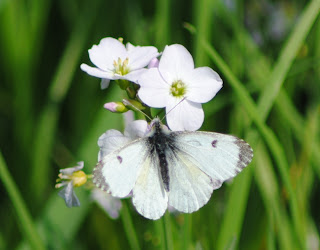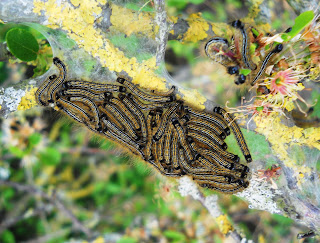
This blog may help people explore some of the 'hidden' issues involved in certain media treatments of environmental and scientific issues. Using personal digital images, it's also intended to emphasise seasonal (and other) changes in natural history of the Swansea (South Wales) area. The material should help participants in field-based modules and people generally interested in the natural world. The views are wholly those of the author.
Friday 29 April 2011
Seeing the Changes 382
In Loughor, the Honeysuckle (Lonicera periclymenum) and Pedunculate oak (Quercus robur) were coming into flower. It was also fairly obvious that strands of Japanese knotweed (Reynoutria japonica) had been treated with a powerful herbicide. It was, however, still coming through. Spotted Yellow dungflies (Scatophaga stercoraria) and Hoverflies (Volucella zonaria and Chrysotoxum cautum). Also saw female Orange-tip butterfly (Anthocharis cardamines) feeding and a Speckled wood (Pararge aegeria tircis) basking. Beetles were celibrating the Royal wedding. There were mating Phyllobis pomaceus on nettles and Gastrophysa viridula on docks. Pyrochroa serraticornis was more restrained.
Beloved Bugs?
A report from a Sustain survey suggests that 'the Ladybird' (which one and one assumes the respondants can distinguish a Harlequin beetle?) is the most appreciated UK insect whereas 'the Wasp' (again, which one?) is the most hated (http://www.mirror.co.uk/news/top-stories/2011/04/29/the-ladybird-is-our-best-loved-bug-115875-23093268/). Personally, I quite like this Ichneumon fly (Netelia testaceus) that strayed into my kitchen last night.
Thursday 28 April 2011
Seeing the Changes 381
In Bynea, spotted a Common blue (Polyommatus icarus) sunning himself. There was what appeared to be half of a Blackbird (Turdus merulus) eggshell in Loughor.
High as the Kite
There has been much self-congratulatory news about the current UK status of the Red kite (Milvus milvus) that has 'recovered' with encouragement such as the creation of feeding stations from a few breeding pairs in Wales (http://www.rspb.org.uk/wildlife/birdguide/name/r/redkite/index.aspx) to substantial populations also in England and Scotland. One should note that the 'recovery' was at least partially 'fuelled' by introducing birds from Scandinavia (aliens?). The most interesting aspect of this story is that the recovery is largely a consequence of changing attitudes to the bird. When the birds were actively shot and poisoned people blamed them for everything including the demise of song and game birds and even the killing of lambs! The Red kite is clearly more of a vulture-like scavenger of dead animals than a powerful eagle-like bird of prey. I don't think the change in attitude really reflects improve understanding of the bird's nature. It seems more likely that 'birds of prey' have become more popular with the general populace.
Unwelcome Guests?
There is a recent report (http://www.guardian.co.uk/commentisfree/2011/apr/26/invasive-species-killer-shrimps-parrots?INTCMP=SRCH) that the GB Non-native Species Secretariat has targeted a number of 'alien' species for eradication from our borders. These include the 'killer shrimp' (Dikerogammarus villosus) now lurking in Cardiff Bay in the freshwater development as well as the better known examples of the breeding colonies of Ring-necked parakeets (Psittacula krameri) and Monk parakeets (Myiopsitta monachus). One could add to the list species such as the Grey squirrel (Sciurus carolinensis) as well as a whole array of plants including Japanese knotweed and Rhododendron. There are good reasons for attempting to limit the impact of some of these species but the 'black-listing' is somewhat arbitrary. Some species have made their own way to the UK in the fashion of animals and plants that arrived earlier. Other have been inadvertently or deliberately released by gardeners, pet owners and land owners who wanted something a little different (e.g. grey rather than red squirrels). Very little of the UK's flora and fauna can be regarded as pristine. There is a danger that humans attempt to micro-manage environments on the basis of personal preferences or enthusiasms.
Wednesday 27 April 2011
Seeing the Changes 380
In Loughor, male moths continue to arrive. Last night, visited by a Pale tussock (Calliteara pudibunda).
Tuesday 26 April 2011
Seeing the Changes 379
In Bynea, Birdsfoot trefoil (Lotus corniculatus) was in flower and little Common froghopper (Philaenus spumarius) were 'spitting' away. Another night of moth trapping in Loughor generated more Cockchafers and Hebrew character moths but also produced a male Muslin moth (Diaphora mendica) and a Smoky wave (Scopula ternata). The day also generated a hunting Zebra spider (Salticus scenicus).
Monday 25 April 2011
Catch of the Night
Got the moth trap out last night for the first time this year. In addition to a Cockchafer (Melolontha melolontha), got what I think were single specimens of The Miller (Acronicta leporina), Lychnis (Hedera bicruris), Hebrew character (Orthosia gothica), Wood carpet (Epirrhoe rivata) and Marbled pug (Eupithecia irriguata).
Sunday 24 April 2011
Seeing the Changes 378
Surprised to note the invasion of Loughor by five, wet Gower ponies (Equus caballus). Amongst the things they might be tempted to sample were Ramsons (Allium ursinum), Dittander (Lepidium latifolium) and Downy rose (Rosa tomentosa).
Friday 22 April 2011
Seeing the Changes 377
Creeping cinquefoil (Potentilla reptans), Cultivated apple (Malus domestica) and Alexanders (Smyrnium olusatrum) were blooming in Loughor. In Bynea, noted Bluebells (Endymion non-scripta) and Field rose (Rosa arvensis). In Penclacwydd, Red campion (Silene dioica) and Greater stitchwort (Stellaria holostea). In that last location, many of the Hawthorn had tented colonies of small Lackey moth (Malacosoma neustria) larvae. In Loughor, visited by a Shield bug (Picromerus bidens). In Bynea, a Viviparous lizard (Zootoca vivipara) was flattened on the cycle path.
Thursday 21 April 2011
Seeing the Changes 376
In Bynea, Oxford ragwort (Senecio squalidis), a white umbellifer, Wild raddish (Raphanus raphanistrum), Ox-eye daisy (Leucanthemum vulgare), Heath speedwell (Veronica officinalis), Common cleavers (Gallium aparine), Greater celandine (Chalidonium majus), Ground ivy (Glechoma hederacea), Wild strawberry (Fragaria vesca), Lilac (Syringa vulgaris), Silverweed (Potentilla anserine), Black medick (Medicago lupulina) and Red clover (Trifolium pratense) were all in flower. In Loughor, the flowers of Lords and Ladies (Arum maculatum) were complete and Wood forgetmenot (Myosotis sylvatica) were in flower. Also visited by a Cockchafer (Melolontha melolontha) and noted that all the Horse chestnut (Aesculus hippocastanum) were furnished with foral 'candles'.
Subscribe to:
Posts (Atom)
What's In a Critter's Name? 20. Otter
The word 'otter' derives from the Old English word 'otor' or 'oter' This, and similar words, stem from the Proto-In...

-
The UK government continue their quest to turn England's rivers back into sewers. They first facilitated the privatised water companies...
-
Garden plants in France, The Netherlands, The UK and Sikkim (NE India).






























































